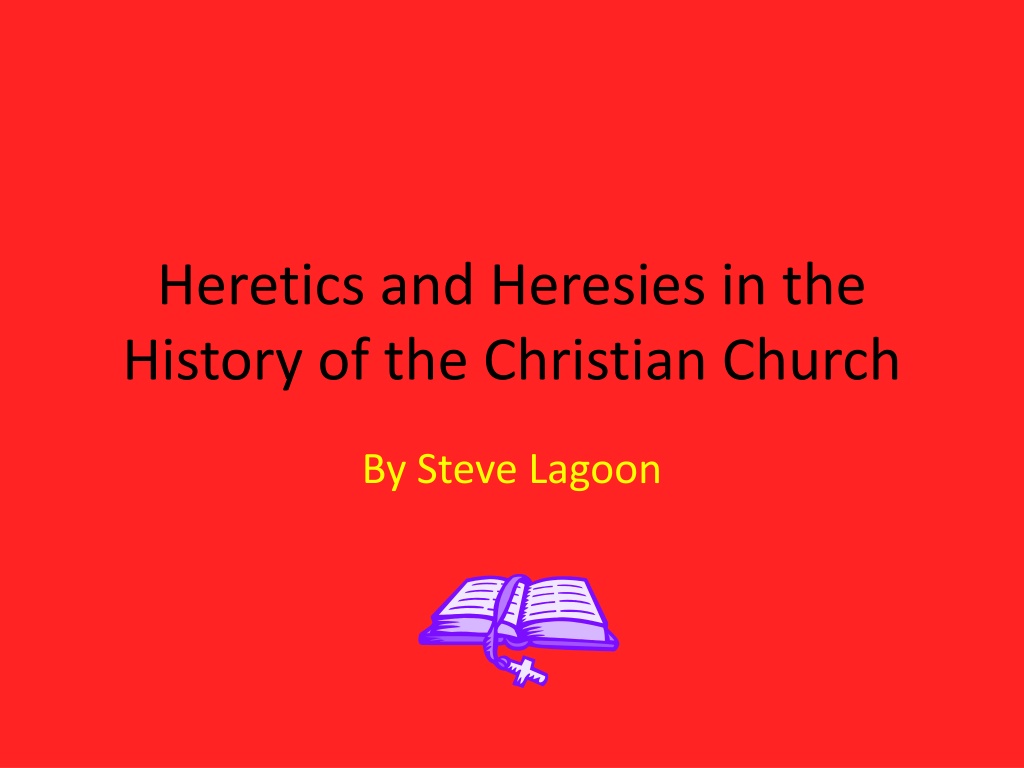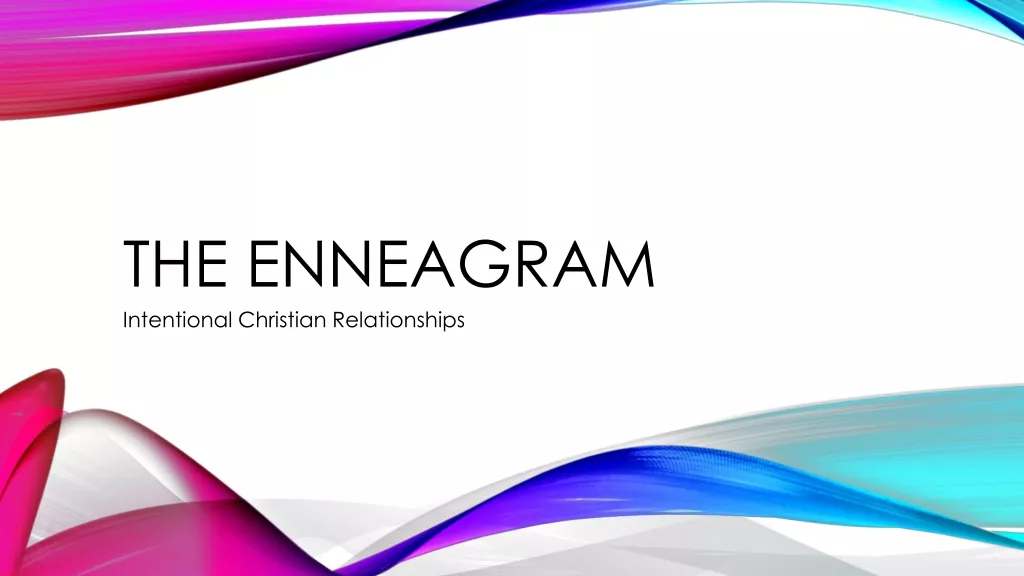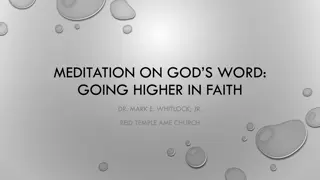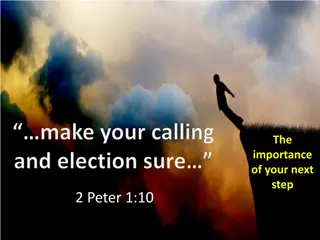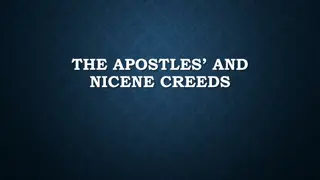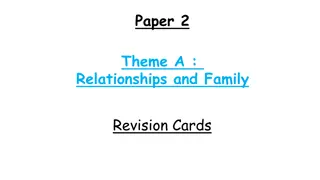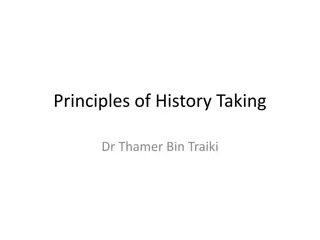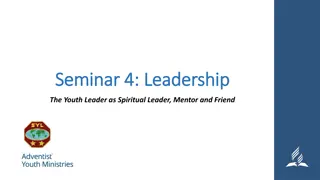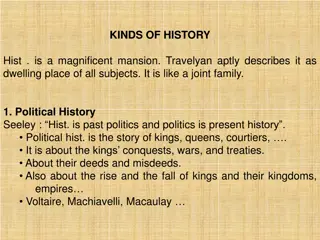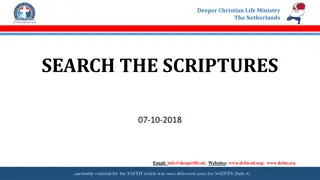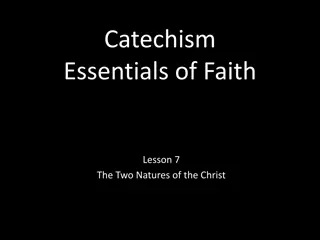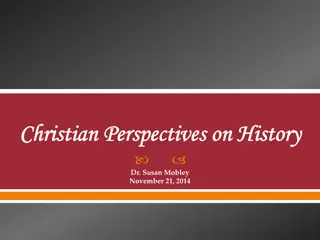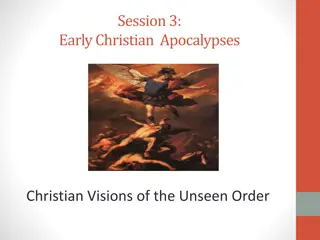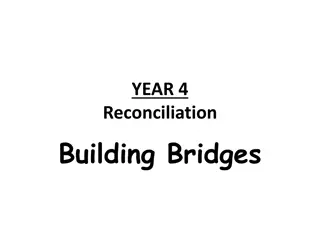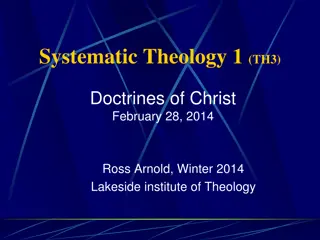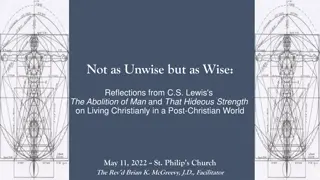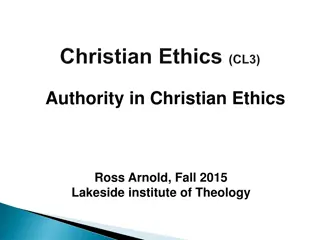Heretics and Heresies in Christian History
The concepts of heresy, defining key terms, and the impact of false teachings on the Christian community throughout history. Learn about different perspectives on heresy and how it has shaped Christian doctrines over time.
Download Presentation

Please find below an Image/Link to download the presentation.
The content on the website is provided AS IS for your information and personal use only. It may not be sold, licensed, or shared on other websites without obtaining consent from the author.If you encounter any issues during the download, it is possible that the publisher has removed the file from their server.
You are allowed to download the files provided on this website for personal or commercial use, subject to the condition that they are used lawfully. All files are the property of their respective owners.
The content on the website is provided AS IS for your information and personal use only. It may not be sold, licensed, or shared on other websites without obtaining consent from the author.
E N D
Presentation Transcript
Heretics and Heresies in the History of the Christian Church By Steve Lagoon
But even if we or an angel from heaven should preach a gospel other than the one we preached to you, let him be eternally condemned! As we have already said, so now I say again: If anybody is preaching to you a gospel other than what you accepted, let him be eternally condemned! Galatians 1:8-9
Defining Terms Before examining specific heretics and heresies, we must define key terms. It has been well said that a heretic is anyone that doesn t agree with me. Though spoken in just, it points out the need to clarify our language, avoiding the extremes of being too narrow or too broad. We do not want to be universalists or over charged heresy hunters.
Key Terms: Heresy Heresy: Any teaching rejected by the Christian community as contrary to Scripture and hence to orthodox doctrine. Most of the teachings that have been declared heretical have to do with either the nature of God or the person of Jesus Christ . . . The term heresy is generally reserved for any belief that claims to be Christian and scriptural but has been rejected by the church as sub-Christian or antiscriptural.
Key Terms: Heresy (2) Bruce Demarest further defines heresy: The primary GK. Word hairesis . . . A school of thought or sect . . . Secondly, developed the meaning of schism or faction that developed within the church . . . Paul s use . . . Suggests that a heretic is a person who is divisive or factiuos . . . Thus 2 Peter refers to . . . False teachers who denied the person and work of Christ.
But there were also false prophets among the people, just as there will be false teachers among you. They will secretly introduce destructive heresies, even denying the sovereign Lord who bought them bringing swift destruction in themselves. 2 Peter 2:1
Key Terms: Cult The term cult has three basic definitions in popular usage today: Theological, socio-psychological, and historical. It is important to understand how it is being used when we come across it.
Key Terms: Cults (Historical) The term cult or cultus is often used in a neutral sense as A system of religious beliefs and rituals. In this definition, the term does not have negative connotations, but is merely describing the religious practices of a certain faith community.
Key terms: Cults (Socio-Psychological) Lewis Rambo s definition is helpful: A group, usually religious or pseudo-religious in nature, that exhibits the following characteristics: It deviates sharply from and strongly rejects prevailing culture dominated by a highly charismatic leader who often proclaims him- herself to be divine or to have special access to the divinity; (definition continued)
Cult: (Socio-Psychological) (Rambo Continued) It exacts total commitment from its followers including the commitment of time and money; it is rooted in a comprehensive ideology, touching on every facet of the adherents life; and, finally, it is aggressive in its efforts to recruit new members, sometimes resorting to manipulative techniques of persuasion [brain washing].
Key Terms: Cult (Theological) Ankerberg and Weldon define a cult as: A separate religious group generally claiming compatibility with Christianity but whose doctrines contradict those of historic Christianity and whose practices and ethical standards violate those of biblical Christianity.
Key Terms: Orthodox Stanley J. Grenz et al define Orthodoxy as: Literally, right praise or right belief (as opposed to heresy). Being orthodox implies being characterized by consistency in belief and worship with the Christian faith as witnessed to in Scripture, the early Christian writers and the official teachings, creeds and liturgy of the church. To be distinguished from the Eastern Orthodox churches.
Biblical Heretics The Bible does indeed mention some heretics by name. The church father Irenaeus called Simon Magus (Acts 8:9-24) The father of all heretics. Other heretics mentioned in the New Testament are: Hymenaeus and Philetus (2 Timothy 2:17), Alexander the Coppersmith (2 Timothy 4:14), Diotrephes (3 John 9), and the Nicolaitans (Revelation 2:15)
Heretics & Heresies of the Early Church This was a period in which the church was gathering the books that would eventually form the New Testament Canon while formulating theology in terms that were clear to the cultures they lived. Council and Creeds helped the church to clarify its beliefs. We will briefly look at three heresies from this period: Gnosticism, Modalism, and Arianism.
Early Church: Gnosticism Gnosticism was especially prominent in the second and third centuries. It was a syncretistic movement combining elements of Judaism, Christianity, Greek philosophy, and Eastern ideas. Gnosticism was ubiquitous in the Roman Empire with many branches, sects, and leaders. It was a dualism of body and soul. The material world was created by a lower god.
Gnosticism (Continued) Salvation was achieved by the soul s escaping the prison house of the body. Secret knowledge (gnosis) was needed for the initiate to secure salvation. Gnostic dualist denied Christ s literal physical body (Docetism), teaching that Christ only appeared to have flesh. Christian Gnostics rejected the Old Testament and much of the New.
Gnosticism (Continued) Major Gnostic teachers were Marcion and Valentinus. Key Christian leaders that opposed Gnosticism were Irenaeus and Tertullian. Key Gnostic writings include the Gospel of Thomas, the Gospel of Philip, and the Gospel of Judas. In 1945, a major discovery of Gnostic writings was discovered in Nag Hammadi in Egypt.
Early Church: Modalism Modalism (Modalistic Monarchianism) is the theological and Christological error that denies the orthodox doctrine of the Trinity and instead teaches that there is a single person in the Godhead. Modalist sought to safeguard the church against the charge of tri-theism or polytheism. It was most popular in the second and third centuries. Modalism took two forms: Sabellianism and Noetian.
Modalism (continued) Noetianist taught that the Father (who is also called the Holy Spirit) is God. At the incarnation, the Father became incarnate (Patripassianism) in the person of Jesus. It was Jesus in his humanity that was properly called the Son. Therefore, at once Jesus was the Father (Holy Spirit) and the Son. This is the view of modern Oneness Pentecostals (Jesus Only advocates).
Modalism (Continued) Sabellianism taught that just as a single actor in a play can portray three successive roles, so the deity acted in three consecutive, but not simultaneous, roles: first as the Father in creation, second as the Son in redemption, and finally as the Holy Spirit during the present church age.
Modalism (continued) Key Modalistic leaders: Noetus of Smyrna, Praxeas, and Sabellius. Key Christian leaders who fought against Modalism were Irenaeus and Tertullian. Modalism suffers from its inability to fairly account for the distinctions of the persons clearly taught in the Bible.
Early Church: Arianism Arianism denied the deity of Jesus Christ. Though it affirms Jesus pre-existence, it denies his eternality ( There was a time when the son was not. ). Jesus was a mighty angelic being, the first creation of God, who then created the rest of the universe. Arianism arose in the early third century.
Early Church: Arianism The battle over Arianism necessitated that Council of Nicea to settle it in 325 A.D. The Council of Nicea strongly condemned Arianism and affirmed the full deity of Jesus Christ. The Chief proponent of Arianism was Arius, the Bishop of Alexandria in Egypt. The chief opponent of Arianism and supporter of orthodoxy was Athanasius.
Heretics & Heresies of the Middle Ages This was a period when the major controversies over theological and Christological debates had been settled. It was also a period in which the Roman Catholic Church and the papacy took center stage. We will examine three groups in this period: The Bogomils, The Paulicians, and the Cathari (Albigensians).
Middle Ages: The Bogomils The Bogomils were a sect that flourished in Eastern Europe during the 10ththrough the 14th centuries, but its stronghold was in Bulgaria. It was founded by Bogomil about 930 A.D., a village priest. Most Bogomils attended services at Eastern Orthodox churches, keeping their identity as Bogomils secret. Were ascetics who rejected wine, meat, and marriage, and procreation.
Middle Ages: Bogomils Bogomil Theology held to a spirit/body dualism. This material world was made by Satan (Satanael), who also created Adam and Eve. Satan procreated with Eve to produce Cain who then is the source of all the problems in the world The true God sent the Logos into the world to save it by his death and spiritual (not bodily) resurrection.
Middle Ages: The Paulicians The Paulicians lived in the area of the Byzantine Empire (i.e. Armenia, Bulgaria, Balkans). They flourished between the seventh to the twelfth centuries. Founded by Constantine (Silas) who rejected the formalism of the Eastern Orthodox Church. Rejected all but letters of Paul and the Gospels in the Bible.
Early Church: Paulicians Paulician leaders named themselves after asscociates of the apostle Paul (Silas, Timothy, Tychicus), and were therefore called Paulicians. Paulicians were dualistic, believing the material world a work of Satan. Jesus was an angel sent by the true god to save mankind. Formed an army that successfully defended itself.
Middle Ages: The Cathari The Cathari (Albigensians) predominated the area of southern Europe (Italy and France) during the twelfth and thirteenth centuries. Held to a spirit/matter dualism in which the world was a creation of the evil god of the Old Testament. Souls were trapped in bodies through endless reincarnations until they achieved salvation.
Middle Ages: Cathari Salvation came be receiving the Holy Spirit in a ceromonial laying on of the hands called the consolamentum. The name Cathari means pure ones or puritans. They lived very ascetic lives rejecting marriage and meats. They had two classes. The Perfecti who had received the consolamentum and the believers who had not yet taken it.
Middle Ages: Cathari In line with their dualism, the Cathari rejected the incarnation of Christ. They taught that Christ was a created being and not God. The Cathari were brutally crushed in a bloody persecution directed by the Roman Catholic Church in the thirteenth century.
Heretics and Heresies of the Modern Period In the modern period, the idea of freedom of religion has been a blessing to mankind. But it has also allowed the explosion of cultic or heretical groups in the modern era. We will examine three heretical groups that have flourished in this pluralistic age: The Mormons, the Jehovah Witnesses, and Christian Science.
Modern Period: Mormonism Mormonism was founded by Joseph Smith Jr. in the United States in 1830. Joseph Smith claimed to have found golden plates in New York State that he translated and published as the Book of Mormon in 1830. It was claimed to be a record of the early inhabitants of the Americas who were descendants of Jews who migrated to America.
Modern Period: Mormonism Joseph Smith claimed to have visions from God directing him to found the Mormon Church since all the rest of Christendom was corrupt. Joseph Smith claimed to receive a revelation to practice polygamous marriage. This practice among the Mormon leaders led to Smith s murder in 1844. Brigham Young became the new Mormon prophet and led the church to its home in Salt Lake City, Utah.
Modern Period: Mormonism Mormons ended practice of polygamy in 1890. Mormons believe they are always led by a living prophet. They believe in polytheism, and that just as God was once a man, each man can also become a god. Mormonism has a works based system of salvation.
Modern Period: Mormonism Official name: Church of Jesus Christ of Latter Day Saints. Practice temple worship for those considered worthy. Temple worship includes baptisms for the dead and eternal marriages. Mormons believe in three levels of heaven and reject orthodox beliefs about hell. Mormon Scriptures include the Bible, the Book of Mormon, Doctrines and Covenants, and the Pearl of Great Price.
Modern Period: Jehovahs Witnesses Jehovah s Witnesses were founded by Charles Taze Russell when he incorporated the Watchtower Bible and Tract Society in 1884. Russell began the Watchtower Magazine in 1879. Russell taught that Armageddon and Christ s second coming would occur no later than 1914.
Modern Period: Jehovahs Witness Jehovah s Witnesses have their own biased translation of the Bible called the New World Translation. They deny the Trinity, the deity of Christ, the bodily resurrection of Christ, and affirm a works- based system of salvation. Believe that they are the only true Christians. Believe that only 144,000 Christians are born- again and go to heaven. The rest are called the great crowd and hope for eternal life on earth.
Modern Period: Jehovahs Witnesses Jehovah s Witnesses are known for their unusual stand rejecting accepted medical practices such the use of blood transfusions. They also reject the celebration birthdays and of holidays like Christmas and Easter. They do not vote or participate in government. Publish the Watchtower and Awake magazines.
Modern Period: Christian Science Christian Science was founded by Mary Baker Eddy in 1866. Mrs. Eddy published Science and Health with the Key to the Scriptures in 1875, which functions as the bible of Christian Science. Christian Science is a syncretistic religion that combines Christian teaching with Eastern religious ideas.
Modern Period: Christian Science Christian Science emphasizing healing. Christian Science denies practically every doctrinal belief held by the historic Christian church including the Trinity, the resurrection of Christ, the atoning death of Christ, the reality of sin and the need for salvation.
